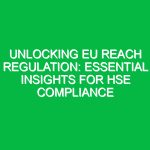Introduction
The European Union Regulation on Registration, Evaluation, Authorization, and Restriction of Chemicals (commonly known as EU REACH) stands as a critical framework for managing chemical substances within the EU. This regulation is not merely a bureaucratic hurdle; it plays a pivotal role in safeguarding human health and the Environment (HSE). As companies navigate the complexities of compliance, understanding EU REACH’s implications in the HSE context becomes essential.
The core purpose of EU REACH is to ensure that the risks posed by chemicals are adequately managed throughout their lifecycle. From production to use and disposal, every stage requires careful consideration. For professionals in health, safety, and environmental management, mastering the nuances of this regulation can lead to significant compliance success and enhanced organizational integrity.
This article will delve into the critical aspects of EU REACH, exploring its components, procedures, and Best Practices within the HSE domain. We will also discuss real-world examples, the associated risks, and the regulatory landscape that shapes the implementation of EU REACH.
Understanding EU REACH in the HSE Context
The Fundamentals of EU REACH
EU REACH, enacted in June 2007, mandates that companies must register chemical substances they manufacture or import in quantities of one ton or more per year. This registration involves providing comprehensive information about the properties, hazards, and uses of these chemicals. The central goal is to ensure that industry stakeholders are informed about the Hazards and risks associated with chemical substances, ultimately promoting safer practices.
In the HSE context, the regulation emphasizes the importance of risk management. Organizations must evaluate and manage the risks associated with hazardous chemicals throughout their lifecycle. This includes assessing exposure levels, implementing Control Measures, and ensuring that any residual risks are minimized. Thus, understanding EU REACH is not just about compliance; it is about fostering a culture of Safety and environmental stewardship.
Key Components of EU REACH
To comprehend how EU REACH intersects with health, safety, and environmental considerations, it’s essential to dissect its key components:
- Registration: Companies are required to register their chemical substances with the European Chemicals Agency (ECHA), providing detailed information about the substance’s properties and uses.
- Evaluation: ECHA evaluates the information submitted to ensure that it meets regulatory Standards. This can lead to further inquiries or additional requirements for companies.
- Authorization: Certain substances deemed of very high concern (SVHCs) may require authorization for use, ensuring that their risks are adequately managed.
- Restriction: The regulation allows for the restriction of certain substances in specific applications if they pose unacceptable risks to health or the environment.
These components encourage proactive measures in chemical management, making it imperative for organizations to integrate REACH compliance into their health and Safety protocols.
Benefits of Compliance with EU REACH
Staying compliant with EU REACH offers multifaceted Benefits for organizations, particularly within the HSE framework:
- Enhanced Safety: By understanding and managing chemical risks, organizations can protect their employees and communities from potential harm, fostering a safer workplace.
- Environmental Protection: EU REACH promotes sustainable practices by restricting harmful chemicals, contributing to broader environmental conservation efforts.
- Market Access: Compliance with EU REACH is often a prerequisite for accessing the European market, ensuring that companies remain competitive.
- Improved Reputation: Organizations that prioritize Chemical Safety and environmental responsibility enhance their brand image, attracting environmentally-conscious consumers and investors.
These benefits underscore the importance of integrating EU REACH compliance into the core operations of any organization dealing with chemical substances.
Best Practices for Achieving EU REACH Compliance
Achieving compliance with EU REACH requires a strategic approach that encompasses various Best Practices:
1. Establish a Compliance Team
Creating a dedicated team responsible for overseeing EU REACH compliance can streamline the process. This team should consist of individuals with expertise in chemical safety, regulatory affairs, and HSE management. They will be tasked with ensuring that all relevant substances are registered and that the necessary documentation is maintained.
2. Conduct Comprehensive Chemical Inventories
Organizations must maintain an accurate inventory of all chemicals used, produced, or imported. This inventory serves as the foundation for identifying substances that require registration under EU REACH. Regular audits and updates can help ensure that the inventory reflects current practices.
3. Evaluate Risks Effectively
Conducting thorough risk assessments is vital. Organizations should evaluate the potential exposure levels associated with each chemical and implement appropriate Control Measures to mitigate risks. This might involve using safer alternatives, enhancing ventilation systems, or providing Personal Protective Equipment (PPE) to workers.
4. Implement Training Programs
Educating employees about the Hazards associated with chemicals they handle is essential. Training programs should cover safe handling practices, emergency response Procedures, and the importance of compliance with EU REACH. By fostering a safety-conscious culture, organizations can reduce the likelihood of incidents.
5. Engage with ECHA and Stakeholders
Maintaining open lines of communication with the European Chemicals Agency and relevant stakeholders is crucial. Organizations should seek guidance when needed and participate in consultations regarding emerging issues related to chemical safety.
Potential Hazards and Safety Considerations
While EU REACH aims to minimize risks associated with hazardous chemicals, organizations must remain vigilant. Some potential hazards include:
- Exposure Risks: Employees may face exposure to hazardous substances, leading to health issues ranging from respiratory problems to long-term illnesses.
- Environmental Contamination: Improper handling or disposal of chemicals can result in environmental damage, affecting ecosystems and public health.
- Regulatory Non-Compliance: Failing to meet EU REACH requirements can lead to significant penalties, including fines and restrictions on market access.
By recognizing these hazards, organizations can take proactive measures to mitigate risks and ensure compliance.
Regulations and Standards Governing EU REACH
EU REACH operates within a complex regulatory framework that includes various directives and Regulations. Some key regulations and standards include:
- CLP Regulation: The Classification, Labelling, and Packaging (CLP) Regulation aligns with the United Nations’ Globally Harmonized System (GHS), ensuring that chemicals are classified and labeled appropriately to communicate hazards effectively.
- Biocidal Products Regulation: This regulation governs the use of biocidal products within the EU, ensuring that they are safe for users and the environment.
- Waste Framework Directive: This directive addresses the management of chemical waste, promoting recycling and recovery while minimizing environmental impacts.
Understanding these regulations is essential for organizations looking to navigate the complexities of EU REACH effectively.
Conclusion
In conclusion, EU REACH is more than a regulatory requirement; it is a pivotal element of a comprehensive health, safety, and environmental strategy. By unlocking the essential guidelines of EU REACH, organizations can ensure compliance while fostering a culture of safety and environmental responsibility.
The journey of navigating EU REACH compliance may seem daunting, but the benefits far outweigh the challenges. By establishing robust compliance practices, conducting thorough risk assessments, and engaging with stakeholders, organizations can protect their employees, the environment, and their market position.
As we move forward in a world increasingly focused on Sustainability and safety, embracing the principles of EU REACH will not only enhance compliance but will also contribute to a healthier planet and workforce. The time for action is now—unlock EU REACH and pave the way for a safer, more sustainable future.


